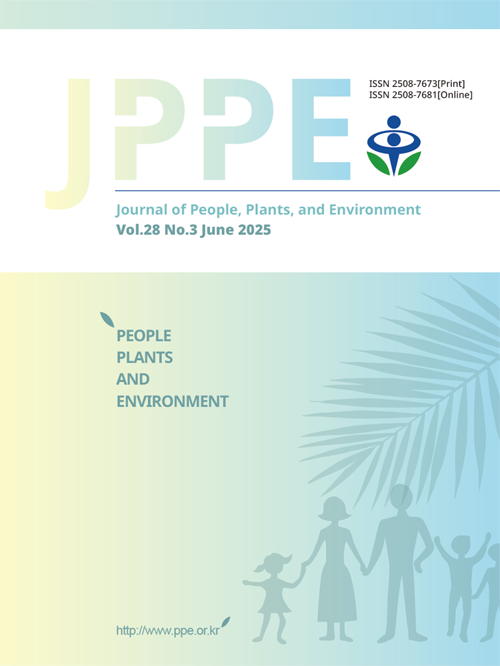학술논문
Carbon Dioxide Uptake of Six Plant Species Under Different Light Intensities
이용수 45
- 영문명
- 발행기관
- 인간식물환경학회
- 저자명
- Huong-Thi Bui Jihye Park Bong-Ju Park
- 간행물 정보
- 『인간식물환경학회지(JPPE)』제28권 제3호, 297~305쪽, 전체 9쪽
- 주제분류
- 자연과학 > 자연과학일반
- 파일형태
- 발행일자
- 2025.06.30
4,000원
구매일시로부터 72시간 이내에 다운로드 가능합니다.
이 학술논문 정보는 (주)교보문고와 각 발행기관 사이에 저작물 이용 계약이 체결된 것으로, 교보문고를 통해 제공되고 있습니다.

국문 초록
Background and objective: Carbon dioxide (CO2) is a common indoor air pollutant that can lead to respiratory issues, impaired cognitive function, and increased absenteeism. Plants play a key role in CO2 absorption through the process of photosynthesis,which is influenced by light intensity. This study aimed to assess the potential of plant species for CO2 reduction under different light conditions, providing baseline data to optimize their effectiveness in improving indoor air quality.
Methods: Six plant species, including three evergreen broad-leaved plants (Pittosporum tobira (Thunb.) W.T.Aiton, Camellia japonica L., Viburnum odoratissimum Ker Gawl. ex Rümpler var. awabuki (K.Koch) Zabel ex Rümpler) and three foliage house plants (Alocasia sinuata, Monstera deliciosa, and Epipremnum aureum) were selected to evaluate their CO2 reduction ability under four different light intensities (10, 40, 80, and 160 μmol m-2 s-1). The plants were exposed to light for 11 hours, followed by a 11 hour dark period. A CO2 cylinder was used to introduce CO2 into the test chamber, and the CO2 concentration inside the test chamber was recorded every 10 minutes over a 22-hour period. Net photosynthesis was also measured for each plant species.
Results: The CO2 reduction capacity varied among plant species and light intensities. All six plant species exhibited thehighest CO2 uptake at 160 μmol m-2 s-1, with uptake decreasing as light intensity decreased. Light intensity had a significant impact on the plants’ CO2 reduction ability, and CO2 absorption continued during the dark period. Among the six species,Monstera deliciosa and Epipremnum aureum demonstrated the highest CO2 uptake.
Conclusion: Plants require adequate light intensity for effective CO2 uptake, making it crucial to examine their ability to assimilate CO2, as plant species that emit CO2 can have a negative impact on health. This will help identify which plant speciescan absorb CO2 without raising CO2 levels, especially in indoor environments where low light conditions are common. This study offers additional insights into the CO2 absorption capacity of plants, enabling landscape researchers to select suitablespecies that contribute to balancing and reducing CO2 concentrations in indoor environments. Further research is necessary to determine the optimal light levels and the right plant species for enhancing CO2 reduction effects in plants.
영문 초록
목차
Introduction
Research Methods
Results and Discussion
Conclusion
References
해당간행물 수록 논문
- 인간식물환경학회지(JPPE) 제28권 제3호 목차
- Carbon Dioxide Uptake of Six Plant Species Under Different Light Intensities
- Modeling Climate Change Impact on Tourism Development in Annapurna Conservation Area, Nepal
- Effects of a Horticultural Therapy Program Incorporating the Enneagram on Self-Understanding and Stress Levels of University Students
- Effects of a Horticultural Therapy Program on Self-Esteem and Self-Efficacy Among Male Adolescents in Youth Shelters
- The Spread of Forest Protection Awareness: An Anthropological Study on the Influence of Writer Nguyen Ngoc on the Central Highlands Community, Vietnam
- A Study on Mortality Rate a nd Resprouts Growth in the Early Period after Planting of Quercus acutissima Carruth
- Chemical Characteristics of Particulate Matter in Underground Shopping Malls
- Delphi Survey to Derive Operating Elements of Horticultural Therapy Programs for the Elderly People with Dementia
- Using MaxEnt to Predict Bombus Ignitus Distribution in Urban Environments
- Impacts of Tangible and Intangible Factors of Care Farms on the Effects of Agro-healing and User Satisfaction
참고문헌
관련논문
자연과학 > 자연과학일반분야 BEST
- 우리나라 국가위기경보체계의 개선방향
- 유아교사의 디지털 수용태도 및 디지털 리터러시가 디지털놀이 지원역량에 미치는 영향
- 신도시 상업시설 실태조사를 통해 상가공실률 상승 원인분석에 관한 연구
자연과학 > 자연과학일반분야 NEW
- 설명가능 인공지능 기반 Flexural Rigidity Matrix를 이용한 교량상 의사정적 차량 하중 추정
- MOLUSCE 모델에 의한 토지피복 변화 예측과 SCS-CN 산정
- 캠핑장 안전사고 현황 및 예방을 위한 제도적 개선방안 연구: 강원 영동지역 캠핑장 사례를 중심으로
최근 이용한 논문
교보eBook 첫 방문을 환영 합니다!

신규가입 혜택 지급이 완료 되었습니다.
바로 사용 가능한 교보e캐시 1,000원 (유효기간 7일)
지금 바로 교보eBook의 다양한 콘텐츠를 이용해 보세요!



